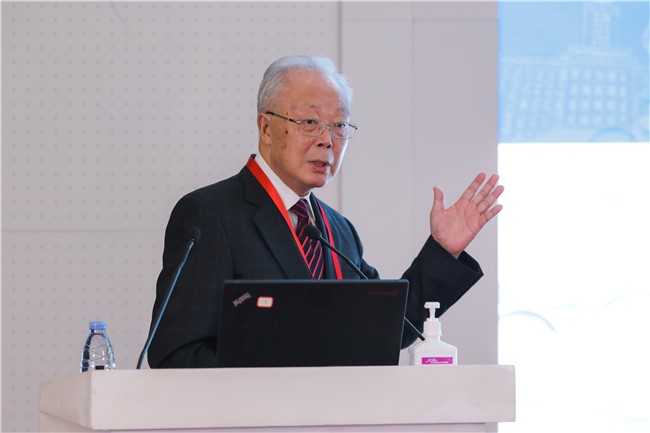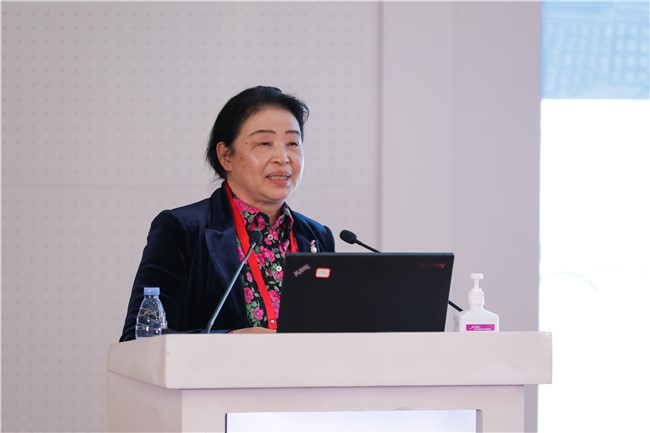Academician Summit Forum Co-hosted by NKU and Tianjin Eye Hospital
NKU joined hands with Tianjin Eye Hospital to establish the Institute of Ophthalmology, NKU. Its inaugural meeting, which is also the Academician Summit Forum, was held in Tianjin Eye Hospital on October 19. Five academicians made wonderful academic reports on the basis of their own research fields.
Xie Lixin, Academician of CAE and Honorary Director of Shandong Eye Institute, was appointed as Chairman of the Academic Committee of the Institute of Ophthalmology, NKU.

He delivered a speech under the title of Prevention and Treatment of Corneal Blindness in China, in which, he introduced the efforts China has made in preventing and treating cataract blindness, retinal disease and myopia. In addition, he also talked about the current status of corneal blindness in the country, as well as what the country has done to prevent and control the disease.
“Corneal transplantation is currently the only means for corneal blindness patients to recover their sight. However, there are three major bottlenecks in this regard: firstly, the long training period for doctors, secondly, the low rate of recovery of sight after surgery, and thirdly, the extreme lack of donors,” mentioned Xie.
To solve the above problems, he put forth some solutions. Actions should be taken to build an information base for keratonosus in the country and set up a national continuing education, remote training platform and consultation center to help reach consensus among experts. Efforts should be made to boost innovative and basic research on corneal surgery, as well as bioengineered cornea research. Of these, more attention should be paid to innovate the bioengineered corneal preparation technology, beef up research on bioengineered corneal mechanics and tissue-engineered corneal material science, and develop the world’s first sustained release intraocular implant. Besides, Xie also elaborated his research on diabetic keratopathy.
“There is still a long way to go in the fight against corneal blindness! Every ophthalmologist should continue to strive for ‘the right to see that everyone should enjoy’,” Xie added at the end of his speech.

In the speech entitled Overview of Myopia Research in Our Laboratory, Yang Xiongli, Academician of CAS and Honorary Director of Institute of Neurobiology, Fudan University, gave an introduction to the research results his laboratory has obtained in the mechanism of myopia and shared the whole story of his research on discovering dopamine-dependent and non-dopamine-dependent mechanisms of myopic refraction. Meanwhile, he presented some new findings on the mechanisms of intrinsically photosensitive retinal ganglion cells involved in myopia onset.

Chen Xiangmei is Academician of CAE, Director of the Institute of Kidney Diseases and Director of State Key Laboratory of Kidney Diseases under Chinese PLA General Hospital. She delivered a report titled Innovation and Talent Cultivation in Eye-Kidney-related Diagnosis and Treatment by Virtue of Both TCM and Western Medicine. According to her report, the fundus is the window of the systemic blood vessels. Hypertension and abnormal blood sugar can cause endothelial dysfunction through various mechanisms, eventually leading to microvascular complications such as nephropathy and retinopathy. So, observing the fundus is very important for the prediction of hypertension and the diagnosis of diabetic nephropathy. Chen has been dedicated to developing an intelligent diagnosis and treatment process for type-2 diabetic nephropathy through multidisciplinary cross-fertilization, in which, the cross of such disciplines as nephrology, ophthalmology and medical imaging provides support for non-invasive diagnosis, intelligent remote diagnosis and large-sample targeted screening.
On top of that, Chen also talked about the holistic view of TCM. She said, “In accordance with TCM, eyes are connected to the five internal organs (heart, liver, spleen, lungs and kidneys) and qi (vitality) runs through the five wheels around eyes (namely, blood wheel, wind wheel, flesh wheel, Qi wheel, and water wheel, which correspond to the five internal organs). Abnormalities of various important tissues and organs, including kidneys, can all be reflected in the eyes. Integrating TCM’s “diagnosis by observation of the eyes” with both optical and AI technologies can help to establish diagnostic models for different diseases. TCM and Western medicine can complement each other’s strengths. It is the focus of today’s work in the field featuring the combination of TCM and Western medicine and it is also the responsibility of Chinese medical practitioners to use the principles of modern science and technology to analyze the efficacy of traditional Chinese medicine, and to create a new paradigm in basic research on diagnostics on the basis of the combination of TCM and Western medicine.
In light of her own experience in discipline development, Chen stressed that both discipline development and talent cultivation should adhere to the integration of clinical practice, scientific research and classroom teaching. Specifically, based on clinical practice, emphasis should be laid on scientific research to foster interdisciplinary talents. At the end of her report, Chen reviewed her deep bond with NKU and sent her best wishes to the Institute of Ophthalmology.

Xu Jianguo, Academician of CAE and Dean of the Research Institute of Public Health, NKU, gave a special report titled Microorganisms in Special Habitats and Emerging Infectious Diseases at the forum. “Usually, there are 1-2 new infectious diseases emerging every one or two years and a major new infectious disease breaking out once every ten years in China. The emergence of new infectious diseases becomes more frequent and the range of pathogens continues to expand. Obviously, infectious diseases have become a long-standing threat for the country,” said Xu Jianguo, adding that in the past, infectious diseases were closely associated with poverty, unsanitary conditions, and natural disasters. But now, they are mostly connected with ecology and human behavior.
Xu mentioned 17 emerging infectious diseases which may break out in our country and proposed a theory of proactive response to emerging infectious diseases, that is, reverse microbial etiology. “The traditional strategy to deal with emerging infectious diseases is to study them and develop prevention and control measures only after they have emerged. But reverse microbial etiology is different. By studying those unknown microorganisms, it will assess their pathogenicity and give early warning so as to prevent the outbreak of epidemics,” continued he.
Furthermore, Xu Jianguo talked about the potential unknown pathogens in special habitats such as Qinghai-Tibet Plateau, glaciers, deep oceans and polar regions. Based on his 10-plus years of experience in research on microbes of wild animals on Qinghai-Tibet Plateau, he explained the pathogens carried by wild animals, including Himalayan marmots, Tibetan antelopes and vultures, as well as theirpathogenic risks.
Biosecurity in extreme environments is an important part of national security, Xu emphasized, adding that studying the large number of unknown microorganisms present in extreme environments, including Qinghai-Tibet Plateau, deep ocean and polar regions, and assessing their hazards are of great significance for the country to prevent emerging infectious diseases and safeguarding national security.

Zhang Yingze, Academician of CAE, made an academic report titled How to Accomplish a Great Task with Little Effort by Clever Maneuvers in Clinical Research and Innovation. The speech started with three questions: what is technological content?What is the standard for measuring the technological content? Is it an impact factor of papers or the contribution to human’s technological advancement? These questions are worthy of deep thought by every one of us in science and technology, said Zhang.
He continued that in the past 500 years, the rise and prosperity of each nation has been supported by landmark discoveries and inventions. We should build cultural confidence, but not be fooled by the appearance of problems; we should break the shackles of inherent thinking, try to think comprehensively and learn to use reverse thinking so as to find the essence of problems and do things in a targeted manner. Scientific workers should pay close attention to the reform and innovation of key steps in clinical research and mull things over in clinical research in a bid to accomplish a great task with little effort byclever maneuvers.
He also talked about his Zhang’s N-Triangle Theory and his team’s research and improvement of PFBN based on the theory. “In the process of innovation, discovering a problem is just the first step in solving it. The only way out is to persevere in research,” said he.
In advancing science and technology, is it important to discover or to invent? Zhang believes that discovery is just like the Yangtze River and the Yellow River which have a prolonged history; and invention is like the Dongting Lake and the Baiyangdian Lake which will dry up if no water flows into them.





